
|
The Liquefied Petroleum
Gas shipping market
in 2003
A disappointing market overall
despite some promising signs |
Significant events
Situation by ship size:
- VLGC
- LGC
- Mid-size
- 8 000/22 000 cbm
- 8 000 cbm and less
Perceptions
The second-hand market
|
|
Significant
events |
|
At the
start of 2003 conditions in the LPG shipping
market were still full of uncertainty and showed
little prospect of improving in the months to
come. This view however was quickly dispelled soon
after the beginning of the year. The market caught
a breeze and started moving within all sectors,
irrespective of ship's sizes, while the price of
LPG and derivatives was also on the rise. We
seemed at last to be leaving the bad times and the
year showed signs of a promising and happier
climate'
Unfortunately, this wind
of hope began to lose strength at soon as February
and March saw the disturbing news of the Iraqi
invasion. We were back to uncertainty, punctuated
by short but strong variations up until the
beginning of the summer, before the market was
able to settle down and reach a cruising speed at
first restrained then slightly more robust at the
end of the year.
Certainly the high
degree of volatility which came in short spells
opened up arbitrage possibilities and
inter-continental product movements, but overall
within the different categories of ship sizes the
year was disappointing and did not afford the
recovery which was eagerly awaited by the various
market players, of which 'some' owners are
confined to LPG carriers (excepting LNG which has
different criteria).
By 'some' we are
referring to those specifically involved only in
LPG trade and who have and continue to operate
their fleet with rock-bottom returns now for a
number of years. Others owners who are active in
different sectors such as oil or dry bulk have at
least had better luck, provided they did not cover
all their positions under long term charters: here
2003 seems to have been a bonanza year.
One of the most striking
events in the shipping market during the year 2003
is perhaps the clean break between the evolution
of the different markets, with the scintillating
performance of the oil and dry bulk sectors
compared to the continuing lacklustre situation in
the petrochemical and more particularly the LPG
markets.
These few figures well
illustrate the picture:

A monthly variation of
$ 20,000 to $ 50,000 with a LPG gas carrier on
time charter or equivalent time charter, often
leads to a feeling of uncertainty and concern from
both sides (long term co-operation, uncertainty as
regards losing their position and market share,
etc.) whilst in the oil and bulk sector the same
variations in amounts are realised but on daily
rates! Business as usual!
The unstoppable surge
forward in China and the skyrocketing of raw
material imports has been a primary reason for the
strong rise in rates. But other reasons which are
more fundamental can be given to explain the gap
that divides movements within the various sectors,
some of which are:
-
LPG markets and
movements are much more restricted and specialised
thus less fluid and volatile than the other
sectors of shipping,
-
a greater sensitivity
and reaction to the variations in product prices,
-
increased production in
closer proximity to consuming areas, such as the
proliferation of petrochemical crackers in the
Far East and S.E. Asia, etc.
Some other trends can be
detected over the last twelve months:
-
Tonnage: a reduction in
the number of ships going for scrap, which is the
logical consequence of the strong increase in
numbers last year when 26 units were demolished.
By the end of November 2003 we have registered 18
units with a capacity of near half a million cbm,
of which one 29,000 cbm built in 1968 was resold
by the demolition yard to an operator in the
Middle East, and the recent sale of a 25 years old
75,500 cbm! The strong rise in the scrap price,
which went from $ 150/ldt in November 2002 to more
than $ 250/ldt in November 2003, is obviously a
consideration when contemplating whether to scrap!
At the same time 29 newbuildings with a total
capacity of 1,076 million cbm came into service
during the year.
-
Mergers, de-mergers, and
take-overs: on April 7th 2003, Oslo and
the shipping world learnt that Bergesen DY was
being taken over by World Nordic an affiliate of
World-Wide Shipping, which is controlled by the
Sohmen family and already strongly present in oil
tankers. The same month the team of Stargas and
Montanari in the 'Medgas Pool' broke up and the
pool was restructured without Stargas who were
facing financial difficulties. September saw the
launching of MNGC (Maersk Norgas Gas Carriers), a
new joint-venture between Norgas (IM Skaugen) and
Maersk for the commercial management of their
ships with a capacity between 5,000 and 12,000 cbm
(37 units). This fleet is due to be operated in
conjunction with the biggest ships between 15,000
and 20,000 cbm run by Scandigas / AP Moller. Also
to be noted was the withdrawal by Tsakos from the
joint venture set up in 2002 with Lauritzen Kosan
on four 4,400 / 6,300 cbm, all now run by the
latter.
-
Prices: the continuation
of the upward movement in oil prices and
derivatives followed an erratic but continuous
trend. Although with less of an impact than China
on the oil and bulk sectors, the US also exerted a
significant pressure on the LPG and ammonia
markets, with the strong surge in imports
resulting from the hike in the price of natural
gas. This price is now close to $ 7/mmbtu, a level
which highly affects the price of propane and
ammonia which are extracted from natural gas.
Our annual table with
the evolution of prices over the last three years
gives the following:
|
|
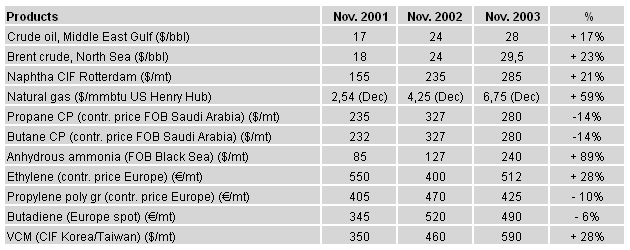
|
|
Together with the gas
price, the freight market was rather disappointing
throughout the year 2003, despite the progress
seen in the larger size sectors of VLGC
(78 / 84,000 cbm), LGC (52 / 59,000 cbm) and
Mid-size (24 / 35,000 cbm) during the second half.
Some figures which
illustrate this point: |
|
|

|
|
It is always important to
remember that the average rates exclude all eventual
idle time of a ship due to inactive periods between
voyages and are neither an indication of an owner's
gross margin on the spot market nor representative of
the level of transactions over period business (two
years and more).
|
|
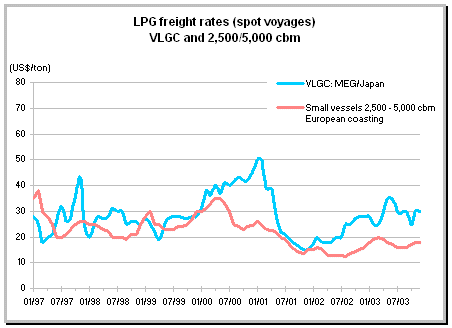
|
|
|
|
Situation by ship size |
|
|
|
|
|
|
The average spot rates on the
reference voyage Middle East Gulf / Japan for the year was
higher than the previous year, despite some much more
pronounced variations both higher and lower. Starting from a
level of close to $ 30 per ton at the beginning of the year,
the market then fluctuated between $ 23-30 per ton before
reaching a peak of $ 40 in June.
These rates represent a time
charter equivalent fluctuating between $ 550,000 and $
900,000 per month, and an annual average of nearly $ 600,000
per month, from which figure a number of short and long term
time charters were concluded at slightly higher levels.
Naphtha demand again largely
contributed to keeping the VLGCs fully employed and nearly a
third of the Bergesen fleet is employed on the naphtha
market (7 to 10 VLGCs) with an average revenue which is very
close to the LPG rates depending on the spot fluctuations of
the naphtha market.
The price of scrapping, which was
higher and well sustained at $ 250 per ton, attracted four
VLGCs, including one 75,000 cbm of 26 years-old which is an
unusual occurrence in this respect, whereas eight
newbuildings were delivered in 2003. By end November 10 VLGC
newbuildings were on order for which deliveries spread out
between 2004 and 2007.
Some studies and statistics
indicate that there will be an important deficit of VLGCs in
the next years given the age profile of this sector and the
foreseen growth in LPG production. If current growth were in
fact to follow these estimates it is likely that a shortage
could occur as from 2005 / 2006, but one must be careful of
a possible reversal in the situation should the pace of new
orders become too intense.
Despite the current buoyant
climate and the important number of multiple orders placed
with the main shipyards, some of them are still able to
offer newbuildings of VLGCs before 2006!
|
|
|
|
|
|
This segment is going through a
transitional phase due to the first deliveries of the new
orders placed two years ago, but currently still strongly
influenced by the age profile of the fleet. Of the 24 units
which comprise this category and currently in service, eight
are over 25 years-old and sixteen more than 20 years-old,
whilst 7 new units are due to be delivered over the next two
years.
Such a marked division in ages and
ships' specifications has resulted in a freight differential
being paid by the market to ships of the older generation,
primarily engaged in the ammonia trade where the terminals
are able to avoid the restrictions imposed by the oil
Majors, compared to higher rates obtained by more modern
ships.
Despite the very small change in
demand compared to the previous year and an idle period
which is still considerable, the average level of short term
time-charter rates (6 to 18 months) rose very slightly,
moving up from a monthly rate of $ 500,000 to $ 550,000 at
the beginning of the year to $ 600,000 to $ 625,000 in the
last quarter of 2003 for the older units, whereas the more
modern vessels were able to achieve $ 700,000 to $ 750,000
per month.
Some Majors have become owners in
this segment size such as Sonatrach with three carriers to
be delivered 2004 / 2005 and Hydro for two 60 000 cbm due
2005 / 2006, but the category remains relatively fragile and
has to depend on the scrapping of the oldest units, which in
all likelihood should occur imminently.
|
|
|
|
This category of vessel stands out
from the other sectors by producing the best results and by
their more consistent and regular performance, thanks to a
demand which is shared between ammonia for a large part and
LPG to a lesser extent.
As is the case for the VLGCs and
the LGCs which have been reviewed above and which is
dominated by one operator Bergesen, in the Midsize sector
Exmar has the majority control.
Although still affected by an
important idle time (11% in 2003, slightly below last year's
level), the average revenues have increased over the year
thanks to a more sustained demand for longer voyage
movements (trans-Atlantic towards the US, cross Europe and
East Med towards India for ammonia).
The flexibility in the size of
these ships allows them to play between the two main markets
of LPG and ammoniac, despite the additional costs of
changing grades. The monthly level of 12 to 18 months
time-charters for a 35,000 cbm vessel in January was roughly
$ 585,000, whereas the current rate is $ 650,000 per month,
and spot demand remains firm. That of a 24,000 cbm
refrigerated was around $ 550,000 during the last quarter
2003.
As we somewhat suspected last
year, this sector has seen an important rush of new orders:
five 39,000 cbm shared between Bergesen, APMoller, and Exmar
for delivery between 2005 and 2006, and one 39 000 cbm for
Bibby, still associated with Exmar in the Midsize pool and
which should be delivered early 2005. Still under
construction for delivery during 2004, is the 35,000 cbm for
Mitsubishi and two Qatari 23,000 cbm.
The current market is not really
conducive to new orders, but the various players, already
heavily involved in the quality regulations required by the
LPG industry and probably also in ammonia in the near
future, are doing their best to maintain their positions
within their size categories and to respond to the quality
improvements being exacted by the majority of oil Majors.
|
|
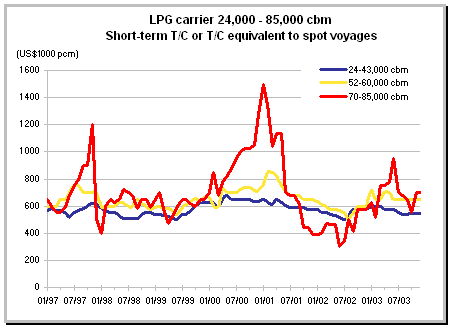
|
|
|
|
The recovery in
petrochemicals has not allowed this sector to take off.
What is even worse is that the results of the chemical
industry overall are fairly negative with everyone
looking to improve productivity. This shipping category
is also affected by the weakness of this industry and
has had to fall back and seek out business in other
markets such as LPG and ammonia.
The results of the first three
quarters were extremely disappointing without any real
improvement over the previous year, situated within a
bracket of $ 275,000 to $ 325,000 for the smaller sizes and
$ 375,000 to $ 475,000 for the larger ones.
Only as from October there was a
growth in demand, often supported by an increase in the
volume of LPG and ammonia movements (inter North Europe,
Middle East Gulf / Asia, trans-Atlantic) indirectly
influenced by imports into the US and a sporadic demand from
the Asian zone for chemical gas. This area in turn was
highly affected by inter Asian movements to the detriment of
inter-continental traffic.
A very wide East/West geographical
dispersal of ships and an increase in the volume of COAs
suddenly generated a rise in demand and consequently freight
rates, both on the spot as well as the short and medium term
time-charter contracts, with the level of $ 575,000 being
broken for the 20,000 cbm sector during the last quarter.
This sector was marked by the
concentration move between the fleet of the Scandigas pool
operated by AP Moller and that of Norgas, which became
official with the creation of the new pool 'MNGC' as
previously stated.
No new order for refrigerated
vessels in this size category has been announced up till
now, whereas in 2003 there was the delivery of three 8,500
cbm and two 10,200 cbm ethylene carriers for Norgas by the
Chinese shipbuilders Zhonghua, as well as two 9,000 cbm
ethylene carriers for Italian account and two 11,000 cbm
pressurised taken on long term time-charter by Vitol. Still
to be delivered is the 'Gaschem Baltic', 8 600 cbm ethylene
carrier, for Gaschem.
And China? Are we going to witness
the after-affects of the explosion in consumption already
under way in this country, brought about by the 150 million
Chinese who are already catching up with same level of
consumption as among the western world? Without counting the
numerous other millions that will follow in the coming
years.
The phenomenal rise in strength of
this part of the world should have repercussions on LPG
demand and derivatives in the East of Suez, even taking into
account the volumes and foreseen expansions on the various
production sites being established in Asia these past few
years.
|
|
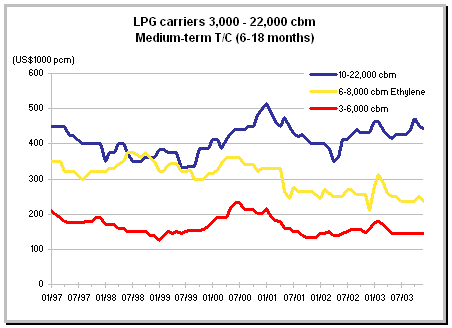
|
|
|
|
Another very disappointing year
for owners, more numerous in this sector. The efforts to
concentrate operations which were made two years ago
(breaking up of the Tarquin fleet, and the merger between
Exmar and Lauritzen on the smaller pressurised vessels), has
not produced any significant increases and levels have
remained 'under pressure' during a large part of the year to
average out on a monthly time-charter rate between $ 130,000
for the small 3,200 cbm and $ 275,000 for the larger size of
6,000 to 8,000 cbm, and a little bit more for the 8,000 cbm
ethylene carriers.
The petrochemical sector has
nonetheless prevented a worsening of idle time and of rates
obtained on the LPG market, with the development of some
long haul movements from Europe to the US or S.E. Asia for
propylene and ethylene.
This sector has always suffered
from an excess capacity of tonnage, but this should begin to
rectify itself given the lack of orders for any
newbuildings. A situation which is totally logical given the
very low return on investment which owners are experiencing
in this category.
Most of the shipyards are in fact
fully booked up until the end of 2006 and the other shipping
sectors (oil, bulk, and LNG) should continue to keep them
busy with new orders.
This new situation risks to upset
the balance between the supply and demand of ships of the
refrigerated and semi-pressurised class, at a time when the
need for new orders can no longer been satisfied with
deliveries in one year and despite the existence of the
smaller Japanese shipyards, which have always been
specialised in this sector at competitive prices.
The orderbook is limited to two
3,000 cbm semi-pressurised / refrigerated for Italian
account for delivery at the beginning of 2004, two 4,000 cbm
also semi-pressurised / refrigerated for Geogas with
Japanese shipyards for delivery in 2005, and three other
7,200 cbm pressurised of which two are for Brazil and the
other Japan with during delivery in 2004.
|
|

|
|
Prospects |
|
As we have seen, the biggest
carriers (VLGC down to Midsize) have survived during
the course of the year slightly better with marginally
higher results as compared to last year, but the other
sectors have suffered again with still too long idle
times and a decline in demand on certain trades.
In short, another unsatisfactory
year for LPG and its derivatives in a feverish condition
compared to the healthy excitements seen in the other
markets, and in an economic environment which has been badly
shaken by the drop in the dollar against the euro.
Nonetheless there are a few
indications that could lead to an improvement in the
situation:
The order book for newbuildings,
especially of ships less than 30,000 cbm, has never been so
slim and close to the critical level needed to replace the
oldest ships. These latter are being more and more
scrutinised by the new safety regulations of the oil Majors,
as well as the new political measures being adopted by some
countries with regards to the safety and age of ships. The
vessels are classified as 'LPG tankers' and improperly being
subjected to the same conditions as oil tankers. An
immediate consequence of this development is that a ship's
depreciation should be calculated on the basis of a shorter
life-span. It is not unreasonable to think that the combined
effect of a growing number of candidates for scrapping
together with a reduced number of new orders will lead to a
mini-shortage of tonnage by 2006.
At the same time we have recently
seen that some owners who are already involved in other
shipping sectors, are beginning to show a disinterest in gas
carriers, especially within the smaller sizes. Given the
poor returns on investment that they have been experiencing
for a long time, some owners are now beginning to question
any new investments in gas and preferring to look at other
shipping sectors. We have here the possibility of a change
in the market structure, together with a likely problem of
renewing the fleet in a couple of years, which is perhaps
more serious than the often quoted risk of the saturation of
shipyards due to an overflow of orders.
The strong surge in American
imports linked to the price of natural gas should continue,
as long as the different LNG projects do not become
operational. The energy 'bonanza' on the Asian continent,
lead by China, is in full force and new requirements for gas
and petrochemicals are to be expected. India, Japan, and
China are all likely to see an increase in the import and
export of products with other geographical zones.
The most serious forecasts
sometimes miss their target due to some small unexpected
elements, which nobody had foreseen but which changes the
outlook (disease, terrorism, etc.). We only hope however
that some of these new trends can develop in a calm and
orderly mood so as to allow the market to steer and set sail
towards a brighter horizon.
|
|
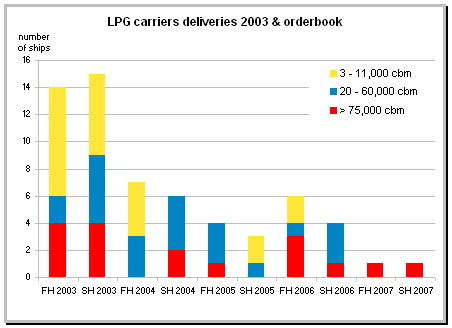
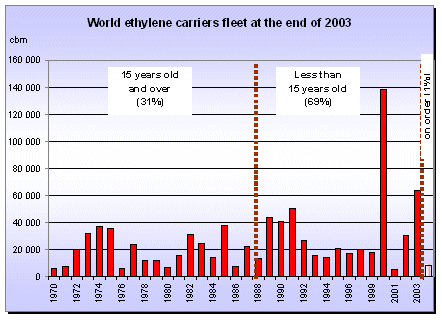
|
|
LPG carriers second-hand market |
Nine sales were reported this
year, of which four for scrapping at a rate between
$ 200 and $ 260 per lightweight ton (which represents
about $4 to 5 million per ship).
Four other sales concerned
ships between 20 and 25 years old and were finalised at
prices from $ 3.0 up to $ 8.5 million for the most
recent (built in 1982).
Two modern candidates for
sale came onto the market at the beginning and at the
end of the year, but obtained similar prices. At the
start to the year Naftomar bought the 'Gas Roman',
78,000 cbm, built in 1990 for around $ 32 million.
Later in the year Bergesen purchased the 'Flanders
Gloria', built in 1991, for $ 33 million. For reference
the latter had been acquired by Exmar five years ago
for $50 million.
- Carriers between 20,000 - 50,000
cbm
No
transaction for further trading has been reported this
year. The episode of the 'Navigator' has still not come
to an end and the story is still an open book.
- Carriers between 10,000 - 20,000 cbm
Three sales for
scrapping have been concluded this year. As to sales
for further trading, the London owner Zodiac has
continued to strengthen his position in this category
with the purchase of the 'Nelly Maersk', 14,700 cbm,
built in 1990, for about $ 15.5 million in June. This
vessel will join the five other ships of similar size
acquired in 2001 and which remain employed in the
'Maersk NGC' pool.
- Carriers between 3,000 and 10,000 cbm
Small pressurised ships remained
at the low levels of last year. Most of the sales have been
made between Far Eastern buyers and sellers, with the
notable exception of 'Chemgas Mango' and 'Chemgas Durian',
3,200 cbm, built in 1997, and which were bought for $ 5.2
million each by Dorian Hellas, who continues to built up its
position in the small size LPG market, after having
purchased last year two ships of similar type and same age
at comparable terms.
As to the semi-refrigerated
market, only the oldest and cheapest ships were able to find
a buyer other than for scrap. We can cite the 'Galp Faro',
5,000 cbm, built in 1982, and sold for $ 2.5 million.
|
|
Shipping and Shipbuilding Markets in 2003
I N D E X
|